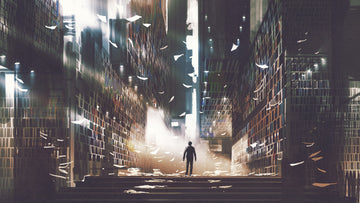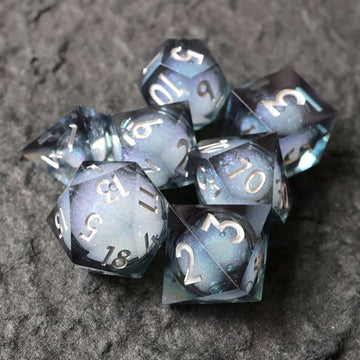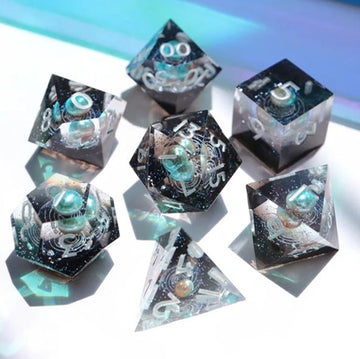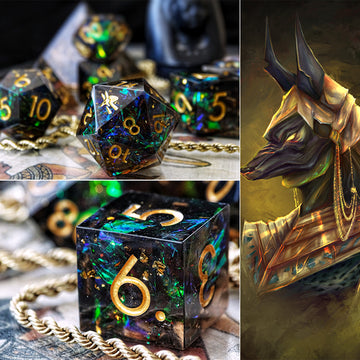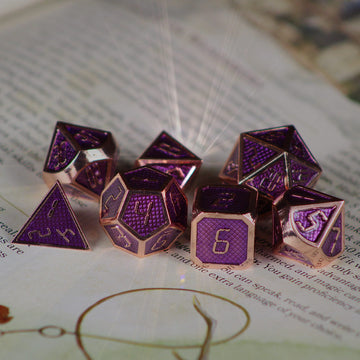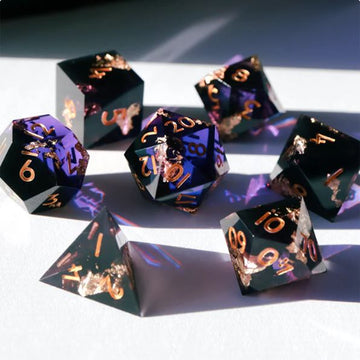The Main Reason Players Are Annoyed and Bored With Exploration (And a Quick Fix!)
By Riley Rath
Table of Contents
- Intro: Exploration and Scenes Strained Relationship
- What Even IS a Scene?
- Scenes Difficulty With ALL of D&D 5e
- Exploration's Unique Struggle With Shared Storytelling
- D&D Exploration's "Complete Scene" Problem
- 5e Exploration's Narration Problem
- How to Create Exploration Encounters/Scenes in D&D 5e
- Conclusion: 5e Exploration Needs More Encounters

Intro: Exploration and Scenes Strained Relationship
First of all, this is part 2 of a series on the exploration pillar of D&D 5e. So if at any point you are like, "what in the nine hells is he talking about?!?" and you haven't read the first post... well... I politely ask that you go read that first post. It is, after all, the FIRST post.
But, if you DID already read the post, then allow me to briefly summarize its contents:
- HOT TAKE: exploration is the most unique and enchanting part of Dungeons and Dragons.
- Problem: there are a whole lotta reasons it sucks or is absent from most adventures.
The rest of the post was about all the reasons it can suck. And the rest of this 2023 exploration blog series is about making exploration a better and bigger part of your 5e campaigns.
But there is one problem with 5e exploration we need to talk about a little more... one CRUCIAL reason why it is so hard to make it fun...
The relationship between the exploration pillar and encounters/scenes.
Short story: it is a dysfunctional, awkward, annoying relationship. The type of relationship that causes you to find any reason at all to cancel dinner plans.
It isn't toxic... exploration and encounters/scenes aren't traumatizing each other... they don't need to break up ASAP. But they DO need some "couples counseling" to figure out how they can make the relationship work.
Weird metaphor aside: if you, the players at the table or the DM, want to make exploration scenes work in your 5e campaigns, you absolutely CAN make it work. And it can be the most FUN part of your campaign.
D&D 5e encounters CAN work with exploration, but it's tricky...
But for it to work, we need to learn some things:
- What are scenes and how are encounters like scenes?
- And why do they present such a challenge to exploration?
- And how can we resolve this difficult relationship?
Join Us as We "Explore Exploration"
Sign Up for Our Newsletter for New Posts
What Even IS a Scene?
In my highly academic research that was definitely not me reading the top 10 results on Google... I came across a lot of different definitions of a scene. All were from the perspective of a book or movie, and D&D is a whole other form of media and storytelling. So I'm not just regurgitating... I'm explaining the ideas to a new audience and in a new way.
In all these forms of storytelling, most notably the book or film, the scene is THE way a story is told. An author may have characters and a plot, but only by putting those characters in scenes, and organizing those scenes into a chain of cause/effect events can it be properly called a narrative.
Bottom line: no scenes = no stories.
In some ways, the basic D&D equivalent of this would be the ENCOUNTER. A campaign is a series of sessions, and a session is a series of encounters.
Book/movie/play scene = D&D encounter
However, an encounter on its own is not necessarily a scene. And a series of encounters is not necessarily a plot. That's because a scene is not just ACTION. It is VALUABLE action.
The scene is essential to the story because stuff CHANGES. And the change isn't random... it moves the story along.
That's why most editors don't insist authors and directors ADD stuff to their story. Usually, they are not like "the fight scene should be 5 minutes longer" or "they should have another scene talking in the coffee shop about the exact same thing." And when they DO add something like that in, it is usually after subtracting, like, 10 other things from the book or movie.
Why? Because aaaaaaaaaaall those scenes are usually unnecessary. They either do not add value to the story or repeat what has already been said (an unspeakable crime: telling the audience something they already know). This is no different for encounters in D&D: in the same way that you want a scene to add value, you also want an encounter to add value to the story.
Valuable Book/Movie Scene = Relevant D&D Encounter
And there are lots of ways a scene or encounter can add value. You can develop a character, world build, introduce a theme, add tension and suspense, etc. No matter what, a scene accomplishes something for the sake of the overarching narrative... the story CHANGES in some shape, way, or form for the better.
For example, take the end of the Fellowship of the Ring:

Image © Embracer Group
- No one cares if Frodo's sword changes from silver to blue... unless that means orcs are approaching and the tone shifts as the stakes are raised.
- No one cares that Merry and Pippin are hiding... unless it allows them to create a distraction for Frodo.
- No one cares that Boromir arrives... unless it is the conclusion of his redemptive arc.
- No one cares that Lurtz stays behind to finish of Boromir... unless it sets up a one-on-one battle with Aragorn.
- No one cares that Aragon puts on some new wrist gauntlets... unless it represents his keeping a promise to Boromir and accepting his destiny to be king.
All of these elements comprise the Amon-Hen scene. They are not only there because they are visually or emotionally stunning, but ALSO because they show the audience a valuable change necessary for the story.

Explore Our D&D 7-Dice Sets
Scenes Difficulty With ALL of D&D 5e
Now that we have established what a scene is in a story, and the D&D equivalent being an encounter... can anyone tell me the problem?
Go ahead... don't be shy... raise your hand!
Yes, you, reading right now on the screen...
Precisely, great answer... I'll repeat it now for everyone in the back.
D&D IS CRAZY RANDOM cHAoTiC NONSENSE!!!

Image does not belong to Awesome Dice
D&D is shared storytelling... NOBODY has control over an encounter in D&D! There are all sorts of personalities and perspectives jostling and improving their way through every... single... D&D encounter. No D&D "scene" will ever be as seamless as a book or movie.
Even the DM, who is the closest thing to "the author," only as a tiny fraction of the power to dictate how an encounter/scene goes. They'll do their best, but there are going to be lots of encounters woven throughout the campaign that barely connect to the overall plot.
Furthermore... D&D is NOT only a storytelling method... it is also a GAME! It has weird dice and weirdly expensive minis. It has chapters of combat rules and unspoken rules where you just have to play a horny bard. There are pages and pages of magic spells and magic items. Player characters named "Sir Fart-mouth III" can be customized like lego sets to deal 117 damage in a single hit.

D&D 5e is also a game, with different priorities than narratives.
D&D 5e is a hybrid... a unique blend of storytelling device and tabletop game. And because it's a fun game people play... not only a carefully crafted work of art... it isn't going to follow all the "rules" of storytelling. There are going to be a bunch of wasted, value-less encounters ("bad scenes").
For example, sometimes encounters are inserted into the story because the players have role-played for 2 hours and clearly everyone could use something exciting. Or sometimes they extend because the players are having fun talking with a silly NPC the DM had come up with on the spot, with an even sillier voice.
And because of that, the "scene/encounter" analogy isn't a perfect fit; on some level, we are comparing apples and oranges.
Despite the problems, the social and combat encounters ARE scenes.
But while a perfect scene structure may be nearly impossible for any session of D&D, the scene/encounter comparison does fit rather neatly with the social and combat pillars.
Most role-playing and social encounters involve characters talking as they share a drink, walking along the road, or standing before the king in a throne room... all of which are classic scenes. And while combat may take 3 hours to resolve, when players look back at and summarize the action, it is a self-contained, exciting scene that fits with the narrative.
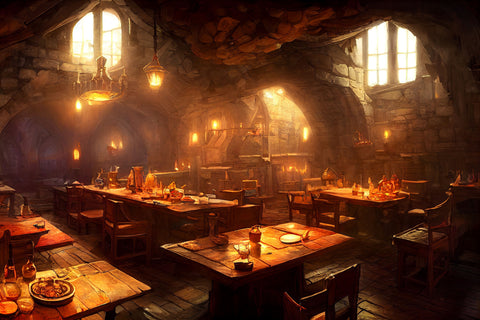
Furthermore, social and combat encounters are well-defined in the rules and understood by the D&D community. Because of that, they have an easy time balancing the tension between storytelling and game play. It is no surprise that people find them a lot of fun, and most of our adventures are dominated by them.
But the exploration pillar is different... it STRUGGLES with encounters.
Exploration's Unique Struggle With Shared Storytelling
The exploration pillar does not have encounters like the social and combat pillars do.
So much of exploration is navigating a dungeon, or traveling, or wandering a town. And when players do this, they are certainly playing the game of D&D 5e... but they aren't experiencing an encounter... they aren't in a scene.
Usually their exploring pays off with a social or combat encounter, but while players are engaging in the exploration pillar, they are not actually in an encounter. They are just transitioning between encounters.
Let me sum up the problem:
-
Exploration = no encounters
-
No encounters = no scenes
-
No scenes = no story
-
No story = exploration cannot participate in "shared storytelling."
I cannot stress this enough... this is a HUGE problem for the exploration pillar.
While its game play is great, D&D is not JUST a game... it is also cooperative storytelling. And if exploration cannot participate in the storytelling part of D&D 5e, then it is not going to resonate with the majority of the D&D 5e community.
Exploration has a hard time really, truly, fully being a part of D&D like the combat and social pillars are. As a result... exploration is forgotten... neglected... ignored. Players and Dungeon Master's alike don't know what to do with it.
Exploration is the "forgotten pillar" because it only fits with half of D&D 5e.
Before we look at the solution, let's look at the two major reasons exploration struggles with encounters/scenes.

Explore Our D&D 7-Dice Sets
D&D Exploration's "Complete Scene" Problem
I wasn't completely honest above when I talked about a scene... it's more than just an encounter with meaningful change...
A scene is also a mini story in and of itself.
It has a setting and action that takes place in that setting over a period of time. It has a built-in structure, complete with a beginning, middle, and end. There is conflict that is presented or developed and resolved in a way that leads to the next scene.
A scene is a story within a story.
This is why authors and directors pull their hair out over each and every scene in their book/movie. The whole story does not work unless each individual "mini story" works. The quality of the whole depends on the execution of the parts. So like a conductor composing an orchestra, or an architect designing a building, they fix and tweak each detail to make sure the scene flows and is a perfect, complete piece of a whole.

Image does not belong to Awesome Dice
Social and combat encounters, on the other hand, have the potential to be complete scenes.
Now, no matter how chaotic combat and social encounters often are, they can fit this idea of a complete scene.

Image does not belong to Awesome Dice
- A battle with a hill giant, though completely unplanned, inevitably will fall into a structure. Players encounter the hill giant's liar and eventually meet the hill giant. Tension and pacing escalates as they fight, reaching the climax with the killing blow. Finally, the party deals with the aftermath: healing and looting.
- A social encounter in a tavern can be a scene between an exhausted party and a group of drunk gang members. The players can enter the setting, relieved to have survived the hill giant. They can then draw the attention of the gang, and choose how they want to navigate that conflict.
5e exploration, in its current state, can never be a "complete scene."
I shouldn't say never... solving an Indiana Jones puzzle in a forbidden dungeon can result in a scene. But that is the exception, not the rule. Usually, D&D exploration is searching a library for an old tome, charting a dark forest for a magical spring, or trekking across hostile badlands.

And while those are actions, valuable actions that change the story... none are complete scenes. The setting constantly changes without additional impact. The passage of time is not felt by the players. There is no 3-part structure... no rising tension... at best, just the presentation of a problem and players solving that problem. It has more similarities to a science experiment than a scene.
And yet... all these things happen in our games. If they are not complete scenes... then what are they? What is taking place instead?
5e Exploration's Narration Problem
A lot of time spend exploring in D&D 5e is occupied by narration/exposition.
Now, that is not all bad! Every good book has narration and every good movie has exposition. It is important to keep the audience informed with important details and summarize what is going on.
But just because something is important does not mean it is interesting. And when something is important, but boring, you can save a lot of time and maintain good pacing in your story by simply narrating it or including some exposition. Confusion is the enemy of enjoying a good story, and narration keeps characters, plot, the world, etc. CLEAR for the audience.
BUT... and this is a big but... narration/exposition violates the cardinal rule for making a story interesting...
Whenever possible... "show, don't tell."
That's the problem... narration and exposition is 100% "telling." And when you tell too much, or in the wrong way, or for too long... the story stops being interesting.

Gif does not belong to Awesome Dice
For D&D, the phrase could be: "whenever possible... role-play, don't narrate/roll a die." But when playing exploration, the majority of the time is spent narrating and rolling dice. And there are 3 reasons that is so uninteresting for 5e players:
-
Narration Takes You OUT of the Story
When D&D is composed of encounters ("scenes"), the players are actually IN the story. They are visualizing the setting, imagining everything as their character and experiencing it in real time. It is what makes D&D special. But when you narrate something instead, they are out of their characters in a magical world and back in their chair as themselves again. They stop being heroes and become players... no longer "in" the game, but "above" the game. And that is a lot less special and fun.
-
Narration Does NOT Involve Player Agency
When players are "in" the encounter, they have a lot more control over what happens in the story. They are no longer listening to you tell a story, a monologue that is briefly interrupted by their rolling here or there... they are now participating in the story. This is ANOTHER essential element that makes D&D special. It also signals that what is taking place requires their involvement in order to be resolved, and thus makes an encounter feel like a defining, important moment. Narration, on the other hand, does not require their involvement, and feels like filler rather than something important.
-
Narration is NOT Emotionally Engaging
When players are "in" the moment of an encounter, feeling and thinking as their character... and when they have agency, able to creatively impact what happens... they FEEL things. They are engaged, attentive, living vicariously through the character and building powerful, emotional connections with the story and with one another. Narration, being more informing than experiencing, has a hard time engaging emotionally. Few will shed tears listening to a friend give a speech about some fantasy stuff.

Explore Our D&D 7-Dice Sets
.
How to Create Exploration Encounters/Scenes in D&D 5e
So far, this blog post has been pretty negative... I have basically explained/ranted why exploration will never, ever be fun for anyone ever again.
In summary... exploration doesn't lend itself to encounters/scenes, which means it has a hard time being fun for players and contributing to shared storytelling.
But... now we get positive! After all, it is a PILLAR of D&D, and it can be so much more than a necessary, but boring evil in our games. You CAN turn exploration into an exciting, engaging, fun encounter for you and your players.
Here's how:
Make an Exploration Encounter a Series of Mini Encounters
Just like scenes are mini-stories that comprise a narrative... use mini-encounters to comprise an overall exploration encounter. Let me use an example: your players need to get into a castle dungeon and are exploring the castle to find out how.

First, you narrate, describing what the castle looks like, feels like: you establish the setting. Then, you give them free reign to explore the area, discovering clues the reveal unknown things about the castle as they search for the key to the dungeon door.
They will investigate rooms...

... talk to NPC's...

Image does not belong to Awesome Dice
And maybe have to preform some skill checks or saving throws.

But rather than treating each of those individual things as an encounter/scene... you treat the whole "exploring the castle" as a single encounter/scene.
As a DM, you establish the setting and use your narration to maintain the tone. But with each "mini encounter," you build out the encounter to feel like a scene:
- You establish the setting
- You present dilemmas to your players
- Allow tension to rise and fall
- And weave their actions into a beginning, climactic middle, and end
- Transitioning them to the next encounter/scene
- The encounter lasts a distinct period of time, which players live
- And valuable story change takes place
With this method, will you still be narrating a lot? Absolutely. But this is unavoidable for exploration. It is up to the DM to tie it all together, using the right amount of narration at the right times to make it all an exciting encounter.
But this method solves three of the exploration pillar's problems:
-
It allows it to have a "complete scene"
-
It limits narration to when it's necessary
-
It allows players to inhabit the world, engage emotionally, and have agency.
Conclusion: 5e Exploration Needs More Encounters
A huge reason the exploration pillar is neglected by DMs and players alike is because it fits well within the "game" part of D&D 5e, but not the "cooperative storytelling" part.
It does not lend itself to encounters... which means it does not really have "scenes"... which means it struggles to contribute to the story part of D&D.
I offered one way DM's can craft engaging exploration encounters, but it is a little bit one-dimensional. It lacks the creative variety of role-playing and the strategic (but still cinematic) excitement of combat.
The solution?
Exploration needs NEW rules for its own unique encounters.
Consider how D&D 5e has adopted 4e's "skill challenge." I believe skill challenge belongs to the exploration pillar more than anything else.
Usually in a skill challenge players are trying to discover a solution (and often moving across space). They are actively coming up with creative justification for whatever skill they choose to overcome the obstacles. The DM adjudicates their actions, describes their impact upon the challenge, and continues to the next player.
Skill challenges, while actually belonging to 4e, are very popular in D&D 5e; I would say the majority of tables have played one at least once.
And while they can be run very poorly by inexperienced DMs, they can also be extremely fun! Sure they have a lot of narration, but they remain tense, creative, engaging, and sometimes essential for telling the story!
The skill challenge is a perfect example of what more "exploration encounters" can do to our 5e campaigns... and proof that, for both our enjoyment and story's sake, we need more. So many fun staples of any adventure fall into he category of exploration:
- Chase sequences
- Players solving a mystery
- Heist encounters
- Long distance travel
- Survival
- True exploration or a wilderness
And here at Awesome Dice, we are going to explore them all, one by one. We'll offer insight and add rules, all so that exploration can resolve its issues with scenes and be a true pillar of the shared storytelling that is Dungeons and Dragons.
If You Found This Blog Post Helpful
Please Help Us Out By Joining Our Newsletter
We Post a Blog at Least Once a Month!
"Sign Me Up!"
Riley Rath

Riley is a freelance copywriter, content writer, and marketer based out of Spokane, WA. He is thankful to have the opportunity to combine his passion for imaginative role-playing to help FLGS, tabletop, board game, and D&D related businesses communicate their distinct value to players everywhere. When not playing or writing about board games or DnD, he is busy hiking, cooking, and gardening... very hobbit-like for a 6'4" dude.


